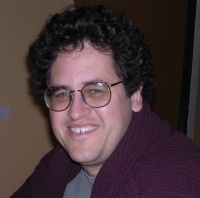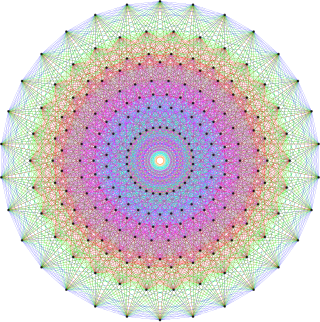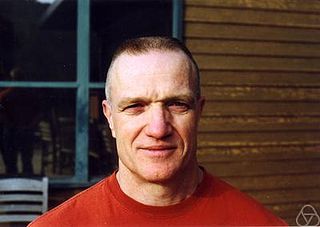Related Research Articles
In mathematics, the octonions are a normed division algebra over the real numbers, a kind of hypercomplex number system. The octonions are usually represented by the capital letter O, using boldface O or blackboard bold . Octonions have eight dimensions; twice the number of dimensions of the quaternions, of which they are an extension. They are noncommutative and nonassociative, but satisfy a weaker form of associativity; namely, they are alternative. They are also power associative.
In mathematics, hypercomplex number is a traditional term for an element of a finite-dimensional unital algebra over the field of real numbers. The study of hypercomplex numbers in the late 19th century forms the basis of modern group representation theory.

John Carlos Baez is an American mathematical physicist and a professor of mathematics at the University of California, Riverside (UCR) in Riverside, California. He has worked on spin foams in loop quantum gravity, applications of higher categories to physics, and applied category theory. Additionally, Baez is known on the World Wide Web as the author of the crackpot index.
In mathematics, the Cayley–Dickson construction, sometimes also known as the Cayley–Dickson process or the Cayley–Dickson procedure produces a sequence of algebras over the field of real numbers, each with twice the dimension of the previous one. It is named after Arthur Cayley and Leonard Eugene Dickson. The algebras produced by this process are known as Cayley–Dickson algebras, for example complex numbers, quaternions, and octonions. These examples are useful composition algebras frequently applied in mathematical physics.

In mathematics, a simple Lie group is a connected non-abelian Lie group G which does not have nontrivial connected normal subgroups. The list of simple Lie groups can be used to read off the list of simple Lie algebras and Riemannian symmetric spaces.

In mathematics, G2 is three simple Lie groups (a complex form, a compact real form and a split real form), their Lie algebras as well as some algebraic groups. They are the smallest of the five exceptional simple Lie groups. G2 has rank 2 and dimension 14. It has two fundamental representations, with dimension 7 and 14.

In mathematics, F4 is a Lie group and also its Lie algebra f4. It is one of the five exceptional simple Lie groups. F4 has rank 4 and dimension 52. The compact form is simply connected and its outer automorphism group is the trivial group. Its fundamental representation is 26-dimensional.

In mathematics, E6 is the name of some closely related Lie groups, linear algebraic groups or their Lie algebras , all of which have dimension 78; the same notation E6 is used for the corresponding root lattice, which has rank 6. The designation E6 comes from the Cartan–Killing classification of the complex simple Lie algebras (see Élie Cartan § Work). This classifies Lie algebras into four infinite series labeled An, Bn, Cn, Dn, and five exceptional cases labeled E6, E7, E8, F4, and G2. The E6 algebra is thus one of the five exceptional cases.

In finite geometry, the Fano plane is a finite projective plane with the smallest possible number of points and lines: 7 points and 7 lines, with 3 points on every line and 3 lines through every point. These points and lines cannot exist with this pattern of incidences in Euclidean geometry, but they can be given coordinates using the finite field with two elements. The standard notation for this plane, as a member of a family of projective spaces, is PG(2, 2). Here, PG stands for "projective geometry", the first parameter is the geometric dimension and the second parameter is the order.

In mathematics, E8 is any of several closely related exceptional simple Lie groups, linear algebraic groups or Lie algebras of dimension 248; the same notation is used for the corresponding root lattice, which has rank 8. The designation E8 comes from the Cartan–Killing classification of the complex simple Lie algebras, which fall into four infinite series labeled An, Bn, Cn, Dn, and five exceptional cases labeled G2, F4, E6, E7, and E8. The E8 algebra is the largest and most complicated of these exceptional cases.

In the theory of algebraic plane curves, a general quartic plane curve has 28 bitangent lines, lines that are tangent to the curve in two places. These lines exist in the complex projective plane, but it is possible to define quartic curves for which all 28 of these lines have real numbers as their coordinates and therefore belong to the Euclidean plane.

Many branches of mathematics study objects of a given type and prove a classification theorem. A common theme is that the classification results in a number of series of objects and a finite number of exceptions — often with desirable properties — that do not fit into any series. These are known as exceptional objects. In many cases, these exceptional objects play a further and important role in the subject. Furthermore, the exceptional objects in one branch of mathematics often relate to the exceptional objects in others.
In mathematics, an Albert algebra is a 27-dimensional exceptional Jordan algebra. They are named after Abraham Adrian Albert, who pioneered the study of non-associative algebras, usually working over the real numbers. Over the real numbers, there are three such Jordan algebras up to isomorphism. One of them, which was first mentioned by Pascual Jordan, John von Neumann, and Eugene Wigner and studied by Albert (1934), is the set of 3×3 self-adjoint matrices over the octonions, equipped with the binary operation
In mathematics, the Freudenthal magic square is a construction relating several Lie algebras. It is named after Hans Freudenthal and Jacques Tits, who developed the idea independently. It associates a Lie algebra to a pair of division algebras A, B. The resulting Lie algebras have Dynkin diagrams according to the table at the right. The "magic" of the Freudenthal magic square is that the constructed Lie algebra is symmetric in A and B, despite the original construction not being symmetric, though Vinberg's symmetric method gives a symmetric construction.

In mathematics, quaternions are a non-commutative number system that extends the complex numbers. Quaternions and their applications to rotations were first described in print by Olinde Rodrigues in all but name in 1840, but independently discovered by Irish mathematician Sir William Rowan Hamilton in 1843 and applied to mechanics in three-dimensional space. They find uses in both theoretical and applied mathematics, in particular for calculations involving three-dimensional rotations.

Robert Leamon Bryant is an American mathematician. He works at Duke University and specializes in differential geometry.
The Levi L. Conant Prize is a mathematics prize of the American Mathematical Society, which has been awarded since 2001 for outstanding expository papers published in the Bulletin of the American Mathematical Society or the Notices of the American Mathematical Society in the past five years. The award is worth $1,000 and is awarded annually.

Scott A. Wolpert is an American mathematician specializing in geometry. He is a professor at the University of Maryland.
Jürg Peter Buser, known as Peter Buser, is a Swiss mathematician, specializing in differential geometry and global analysis.

The Geometry of the Octonions is a mathematics book on the octonions, a system of numbers generalizing the complex numbers and quaternions, presenting its material at a level suitable for undergraduate mathematics students. It was written by Tevian Dray and Corinne Manogue, and published in 2015 by World Scientific. The Basic Library List Committee of the Mathematical Association of America has suggested its inclusion in undergraduate mathematics libraries.
References
- Baez, John C. (2002). "The Octonions". Bulletin of the American Mathematical Society. 39 (2): 145–205. arXiv: math/0105155 . doi:10.1090/S0273-0979-01-00934-X. ISSN 0273-0979. MR 1886087.
- Iliev, A.; Manivel, L. (2005). "The Chow ring of the Cayley plane". Compositio Mathematica. 141: 146. arXiv: math/0306329 . doi:10.1112/S0010437X04000788.
- Ahiezer, D. (1983). "Equivariant completions of homogenous algebraic varieties by homogenous divisors". Annals of Global Analysis and Geometry. 1: 49–78. doi:10.1007/BF02329739.
- Baez, John C. (2005). "Errata for The Octonions" (PDF). Bulletin of the American Mathematical Society. 42 (2): 213–214. doi: 10.1090/S0273-0979-05-01052-9 .
- McTague, Carl (2014). "The Cayley plane and string bordism". Geometry & Topology. 18 (4): 2045–2078. arXiv: 1111.4520 . doi:10.2140/gt.2014.18.2045. MR 3268773. Zbl 1323.55007.
- Helmut Salzmann et al. "Compact projective planes. With an introduction to octonion geometry"; de Gruyter Expositions in Mathematics, 21. Walter de Gruyter & Co., Berlin, 1995. xiv+688 pp. ISBN 3-11-011480-1